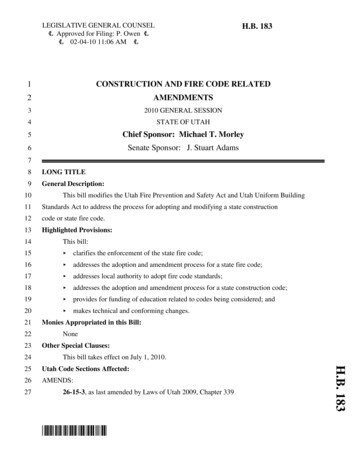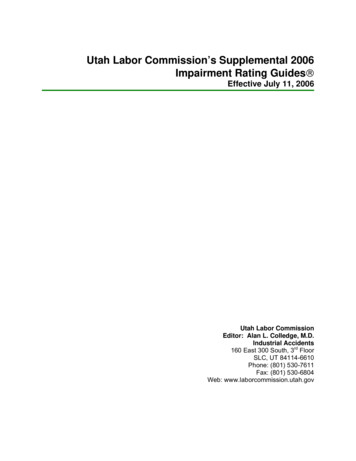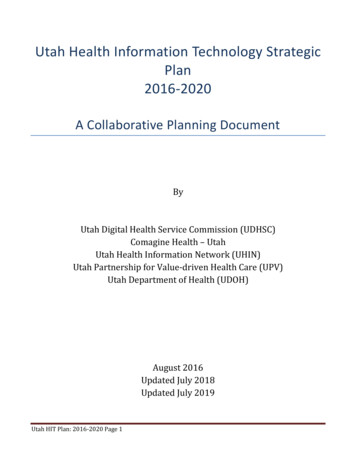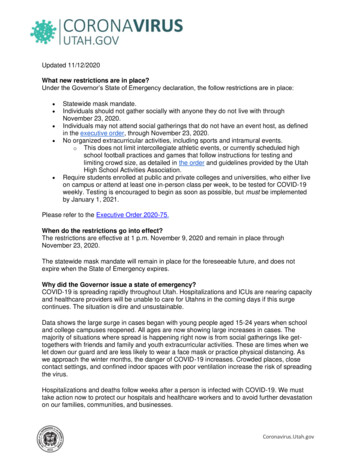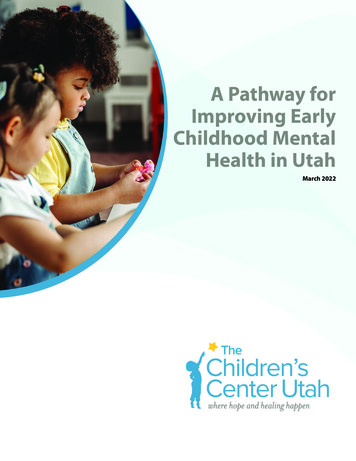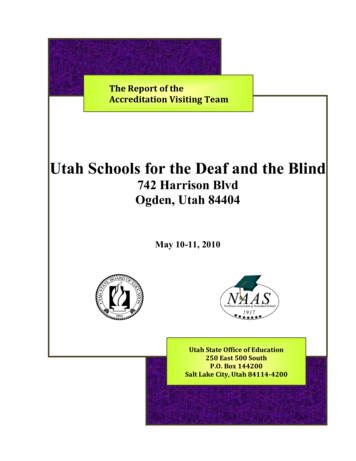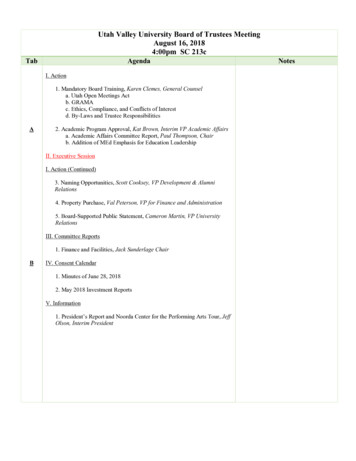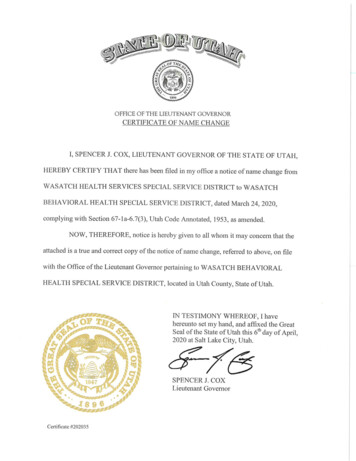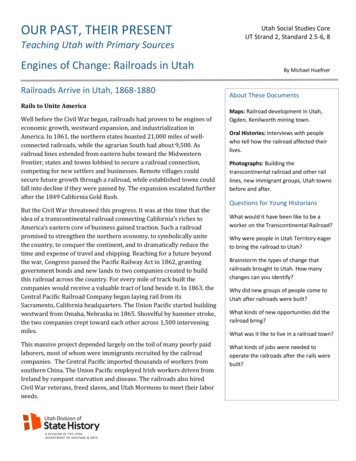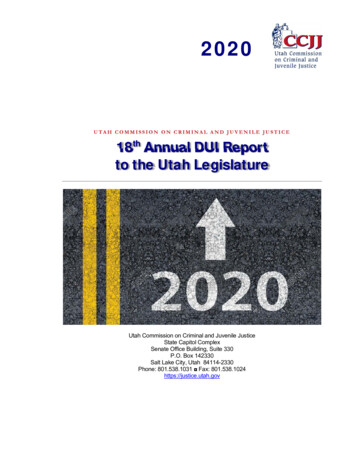
Transcription
2020UTAH COMMISSION ON CRIMINAL AND JUVENILE JUSTICE18th Annual DUI Reportto the Utah LegislatureUtah Commission on Criminal and Juvenile JusticeState Capitol ComplexSenate Office Building, Suite 330P.O. Box 142330Salt Lake City, Utah 84114-2330Phone: 801.538.1031 Fax: 801.538.1024https://justice.utah.gov
1 8T HA N N U A LD U IR E P O R TT OT H EU T A HL E G I S L A T U R EAcknowledgementsThe Utah Commission on Criminal and Juvenile Justice gratefully acknowledges the followingagencies for providing the data for this report: the Administrative Office of the Courts; the UtahDepartment of Human Services, Division of Substance Abuse and Mental Health; and the UtahDepartment of Public Safety’s Highway Patrol, Driver License Division, and Highway Safety Office.Special thanks to Kim Gibb, Robyn LaLumia, Barbra Christofferson, Lynda Reinstein, Jill Sorensen,Tara Zamora, and the Administrative Office of the Courts for their contributions and assistance inpreparing this report.
1 8T HA N N U A LD U IR E P O R TT OT H EU T A HL E G I S L A T U R ETable of Contents(click on page number to go directly to that section)AcknowledgementsTable of ContentsProfile of a Typical Utah DUI Offender in FY 2018 . 1Executive Summary. 3Purpose of the Report . 51 DUI Policy in Utah . 72 Law Enforcement Activities: Arrests & Enforcement Events . 93 Crashes, Injuries, & Fatalities . 174 Court Activities: Adjudications, Sanctions, & Treatment Orders . 215 Driver License Control Hearings . 25Appendix – Tables & Figures . 27Utah DUI Sentencing Matrix . 37
1 8T HA N N U A LD U IR E P O R TT OT H EU T A HL E G I S L A T U R EStatistical Note: Data in this report are current as of October 1, 2020, unless otherwise noted. Dueto rounding, data in the tables in this report may not add up exactly to the totals indicated.
1 8T HA N N U A LD U IR E P O R TT OT H EU T A HL E G I S L A T U R EProfile of a Typical Utah DUI Offenderin FY 2020Arrested for a per se violation (80%)Driver had a .05 or greater blood/breath alcohol concentration, or was impaired by alcohol, drugs, or acombination of the two to the extent it was unsafe to operate a vehicle Arrested by a municipal law enforcement officer (57%) Male (72%) Age 25-36 (37%) Had a blood/breath alcohol concentration (BAC) between .11-.15 Arrested on the Wasatch Front in Weber, Davis, Salt Lake orUtah County (70%) First-time arrestee (72%) Convicted of DUI(76% in Justice Court; 79% in District Court)1
1 8T HA N N U A LD U IR E P O R TT O2T H EU T A HL E G I S L A T U R E
1 8T HA N N U A LD U IR E P O R TT OT H EU T A HL E G I S L A T U R EExecutiveSummaryDUI in Utah: CY 2019 / FY 2020Law Enforcement: DUI-Related Arrests & Enforcement Activities 10,532 DUI-related arrests were made in FY 2020, 537 more ( 5%) than in FY 2019. Despite a slight increase last year, Utah’s DUI-related arrest rate (32.9 per 10,000population) has declined steadily over the past 10 years, with a 34% decrease since FY2011 (associated with 3,284 fewer arrests in FY 2020 than in FY 2011), even as thepopulation has greatly increased in the same time (16% increase in statewide population). The majority of arrests occurred along the Wasatch Front, with Salt Lake, Davis, Utah, andWeber Counties accounting for 70% of the total. While counties outside the Wasatch Frontonly accounted for 30% of the total, this was disproportionate to their population (25%). DUI-related arrests in FY 2020 displayed the following characteristics:o 72% of arrestees were male (25% female, with 2% unspecified).o 37% of arrestees were between 25-36 years of age, followed by 23% 37-48, 14%21-24, 14% 49 and older, and 12% under 21.o The majority of arrests (57%) were made by city/municipal police departments, withthe rest split between Utah Highway Patrol (32%) and county sheriff’s offices (11%).o Over forty percent (41%) of the arrests did not have a BAC reported, and 11% ofarrestees refused testing. Of those with a BAC reported, 43% exceeded .15.Additionally, 10% fell between .05-.07, an increase over previous years with the firstfull fiscal year under the new statutory level (.05) in effect since January 2019.o It was the first DUI-related arrest for 72% of arrestees, with 19% having one priorarrest and another 9% having two or more prior arrests for DUI. The 12% of arrestees under the age of 21 is up slightly (11% in FY2019), and the 1,306total arrests of underage persons is up 19% over 2019 (though in line with FY2017 levels). It is still too soon to see any definitive impacts of changing the statutory BAC level to .05,though there does appear to be a slight increase in arrests after the implementation date. Consistent with previous years, 80% of the arrests were for per se violations where thedriver had a blood/breath alcohol concentration (BAC) over the legal limit (now .05 as ofDecember 30, 2018), or was impaired by alcohol, other drugs, or a combination of the twoto the extent it was unsafe to operate a vehicle.o Drug metabolite arrests, which had increased sharply from FY 2014-18 andremained stable in FY2019, decreased sharply (-41%) in FY 2020. Arrests included 1,981 made during specialized DUI overtime enforcement events such asenforcement blitzes, saturation patrols, and DUI sobriety checkpoints that involved lawenforcement agencies throughout the state. These overtime shifts have been increasing.3
1 8T HA N N U A LD U IR E P O R TT OT H EU T A HL E G I S L A T U R EDUI and Drug-Related Crashes, Injuries, and Fatalities The numbers of DUI/alcohol-related crashes, injuries, and fatalities all decreased lastyear, particularly fatalities, after increases in 2018.o Crashes decreased 2% from CY 2018 to 1,921 in CY 2019; injuries decreased 5%to 1,167 in CY 2019; and fatalities dropped 60% to 19 in CY 2019 the lowestnumber in over ten years. DUI/drug-related crashes, injuries, and fatalities also all decreased in 2019, particularlyfatalities, after significant increases on all indicators in the previous ten years.o Crashes decreased 2% from CY 2018 to 1,039 in CY 2019 (was up 93% 2009-18).o Injuries stayed stable at 774 in CY 2019 (773 in CY 2018, was up 75% 2009-18).o Drug-positive driver fatalities decreased 31% from CY 2018 to 67 in CY 2019. The 97fatalities in CY 2018 had previously represented a 273% increase since 2010. The most common drug types found in drug-positive driver fatalities in CY 2019 weredepressants (e.g., sedatives); marijuana/THC; stimulants (e.g., methamphetamine); andopioids (e.g., oxycodone).Courts: Adjudications and Sanctions In FY 2020, there were 6,568 DUI-related cases disposed by Utah’s Justice Courts.o 76% resulted in a guilty plea or verdict. In FY 2020, there were 2,545 DUI-related cases disposed by the state’s District Courts.o 79% resulted in a guilty plea or verdict. FY 2020 slightly reversed a trend whereby an increasing number and percentage of DUIrelated cases had been handled in the District Courts over the previous ten years.Courts: Orders for Assessment, Treatment, and Education Justice Court judges ordered offenders to undergo a substance use disorder screeningand assessment in 4,392 cases (88% of guilty), ordered substance use disorder treatmentin 3,031 cases (61%), and ordered an educational series in 2,982 cases (60%). District Court judges ordered offenders to undergo a substance use disorder screening andassessment in 1,173 cases (58% of guilty), ordered substance use disorder treatment in1,185 cases (59%), and ordered an educational series in 379 cases (19%). Treatment orders have generally increased over the past ten years in both courts.Driver License Control 5,663 hearings were conducted in FY 2020 to determine if there was sufficient informationto warrant the suspension or revocation of the individual’s driver license.o 4,454 (79%) involved at least one of the parties calling in for the hearing.o In 2,159 (38%) of the cases, no action could be taken against the driver due to theabsence of the arresting officer at the hearing or other factors.4
1 8T HA N N U A LD U IR E P O R TT OT H EU T A HL E G I S L A T U R EPurpose of the ReportThe 18th Annual DUI Report to the Utah Legislature was prepared in accordance with §41-6a-511of the Utah Code. The statute requires the Utah Commission on Criminal and Juvenile Justice toprepare an annual report of DUI related data, including the following: Data collected by the state courts to allow sentencing and enhancement decisions tobe made in accordance with violations involving driving under the influence of alcoholand/or other drugs; Data collected by the justice courts (same DUI related data elements collected by thestate courts); and Any measures for which data are available to evaluate the profile and impacts of DUIrecidivism and to evaluate the DUI related processes of: law enforcement; adjudication;sanctions; driver license control; and alcohol education, assessment, and treatment.5
1 8T HA N N U A LD U IR E P O R TT O6T H EU T A HL E G I S L A T U R E
1 8T HA N N U A LD U IR E P O R TT OT H EU T A HL E G I S L A T U R E1DUI Policy in UtahThe Utah Legislature establishes policy for dealing with driving under the influence of alcohol andother drugs through the passage of bills that are enacted into law. This section summarizes thebills passed by the 2019 Utah Legislature and their impact on DUI policy in Utah.2020 DUI-Related LegislationH.B. 139 DUI Liability AmendmentsRepresentative Steve EliasonThis bill criminalizes a person's refusal to submit to a chemical test for alcohol or drugsrelated to suspicion of driving under the influence of alcohol or drugs in certaincircumstances; provides penalties for a person's refusal to submit to a chemical testfor alcohol or drugs related to suspicion of driving under the influence of alcohol ordrugs; clarifies that driving under the influence is a strict liability offense; clarifiesprovisions related to driving in the wrong direction while driving under the influence;clarifies that the determination whether an individual is in actual physical control of avehicle includes consideration of the totality of the circumstances, and creates a safeharbor-provision related to that determination.7
1 8T HA N N U A LD U IR E P O R TT O8T H EU T A HL E G I S L A T U R E
1 8T HA N N U A LD U IR E P O R TT OT H EU T A HL E G I S L A T U R E2Law Enforcement ActivitiesDUI-Related ArrestsThe Utah Department of Public Safety, through its Driver License Division and HighwaySafety Office, collects information on all DUI-related arrests. In FY 2020, law enforcementofficers made 10,532 arrests, 537 more ( 5%) than in FY 2019. While Utah’s population hascontinued to grow, the arrest rate for DUI-related offenses has declined steadily, with a nearly34% decrease over the past ten years (associated with 3,284 fewer arrests than FY 2011).Utah DUI-Related Arrest Rates byPopulation, FY 2011 - FY 2020DUIDUIPopulationFiscalRelatedRelatedas ofYearArrestArrestsJuly ,161,10531.6202010,5323,205,95832.9DUI-Related Arrest Rates FY2011-2049.831.632.920192020DUI Arrest Rate*20112012201320142015201620172018Source of DUI-Related Arrest Data: Utah Department of Public Safety, Driver License DivisionSource of Population Data: U.S. Census Bureau, Population Division (estimates are as of July 1 of calendar year preceding fiscal year)*DUI-related arrest rate is the number of DUI-related arrests per 10,000 population.Arrests by County & RegionConsistent with past years, the majority of DUI-related arrests during FY 2020 occurred along theWasatch Front, with Weber, Davis, Salt Lake, and Utah Counties accounting for 70% (7,379) ofthe total. Salt Lake County had the highest number of arrests with 3,990 (38%), while DaggettCounty had the fewest arrests with three (see Table A1 in the Appendix for all 2020 data bycounty, as well as a comparison of arrest percentages to total population). The chart below breaksthe 2020 arrests down by region of the state.Non-Wasatch/RuralDUI ArrestsPopulation29.9%24.8%Other Wasatch Front32.2%39.1%Salt Lake County37.9%36.2%Note: “Other Wasatch Front” Davis, Utah, and Weber counties; “Non-Wasatch/Rural” all other counties outside the Wasatch Front.9
1 8T HA N N U A LD U IR E P O R TT OT H EU T A HL E G I S L A T U R EThe previous figure shows an over-representation of DUI-related arrests outside the WasatchFront (29.9%), relative to the total population in the region (only 24.8% of the total population).Additionally, the figure below shows the DUI-related arrest rate trends over time (FY 2011-20) byregion of the state. Consistent with the previous figure, the highest arrest rates in FY 2020 wereoutside the Wasatch Front (39.7 per 10,000 population), followed by Salt Lake County (34.4), andDavis/Utah/Weber counties (27.1). As with the overall rates for Utah seen on the previous page,the rates in each region have seen a downward trend over the past ten years. Salt Lake Countyhas shown the sharpest decline over ten years, though was also responsible for much of theincrease in the past year (see Table A2 in the Appendix for all the rate data by county and region).DUI-Related Arrest Rates* by Region on‐Wasatch/Rural201520162017Other Wasatch Front201820192020Salt LakeNote: “Other Wasatch Front” Davis, Utah, and Weber counties; “Non-Wasatch/Rural” all other counties outside the Wasatch Front.*DUI-related arrest rate is the number of DUI-related arrests per 10,000 population.Characteristics of FY 2020 DUI-Related ArrestsThe figures on the next page show some characteristics of DUI-related arrests, including: Gender: 72% of arrestees were male, while 25% were female (an additional 2% of arrestsdid not have gender specified; see Table A3 in the Appendix).Age: Drivers ages 25-36 accounted for 37% of all arrests, followed by 23% for ages 37-48.12% of arrestees were under the legal age of 21 (see p.12 for more on this, and see TableA4 for full data).Arresting Agency: 57% of all arrests were made by municipal law enforcement agencies,with Utah Highway Patrol responsible for 32% and county sheriffs’ offices responsible for11% (see Table A5).Blood/Breath Alcohol Concentration (BAC): Over forty percent (41%) of the arrests didnot have a reported BAC, while another 11% refused the BAC test. Of those arrests withBAC reported, 43% exceeded .15 (the highest BAC recorded was .47), while 28% fellbetween .11-.15, 14% between .08-.10, 10% between .05-.07, and 6% under .05 (seeTable A6). Arrests in both categories below .08 increased this year (see p.12).Repeat Offenders: 72% of arrests were for a first offense, 19% had one prior offense, and9% were for a third or subsequent offense (see Table A7 for more data by violation type).10
1 8 T HA N N U A LD U IR E P O R TT OT H EU T A HL E G I S L A T U R EBy Month: DUI-related arrests remained consistent throughout FY 2020, with an averageof 878 arrests per month, though there were slightly more in the period between Novemberand February. The highest number of arrests occurred in January (1,020), with the lowestnumber of arrests in April (606; see Table A8). Of note, there appears to be somedecrease in DUI arrest activity in the spring corresponding with the start of the -3637-4849 12.4%14.0%37.1%22.6%13.9%Arresting AgencySheriffCity Police11.2%57.1%Highway Patrol31.7%Blood/Breath Alcohol Content (BAC; See Figure A1) .05 .05-.07 .08-.154.6%2.6%.16-.25 .25 Refused20.0%16.7%3.8%Not Reported40.9%11.3%First-Time vs. Repeat Offenders1st Offense72.3%2nd3rd 18.5%9.2%Month of Arrest1,020 yJun
1 8T HA N N U A LD U IR E P O R TT OT H EU T A HL E G I S L A T U R EUnderage DUI-Related ArrestsAs seen on the previous page, 12% of the DUI-related arrests were offenders under the legaldrinking age of 21. This percentage of the overall arrests is consistent with recent years (seeTable A4), though the 1,306 total arrests in this category represents an increase of 19% overFY 2019, when there were 1,101 underage arrests.Under 21 DUI-Related Arrests FY2010-191,4601,3391,3031,3061,1821,0461,101Under 21 Yrs Old2011201220132014201520162017201820192020Early Impacts of Decreasing the Legal BAC Limit to .05Arrests by BAC Level. Though the data on reported BAC levels discussed above (and in TableA6) is not broken down by month like the overall arrests, there was an increase in arrests with aBAC below .08. This is particularly the case in the.05-.07 range, where the legal limit was movedon December 31, 2018 – 9.7% of arrests were in this range, compared to 7.3% in FY 2019 and4.1% in FY 2018. Reported BAC levels in the highest ranges have decreased. It should be notedthat the data below are only based on arrests where the BAC was reported or obtained (41% hadno BAC reported and 11% of arrestees refused a BAC test, consistent with previous years).Lower Range BAC Levels Reported* inDUI-Related Arrests FY2015-2016.8%14.0%13.0%7.3%4.1%201520162017 �.10*Note: Specific BAC levels are only generally reported in around half of cases. Data distinguishing .05 and .05-.07 not available pre-FY2015.12
1 8T HA N N U A LD U IR E P O R TT OT H EU T A HL E G I S L A T U R EHigher Range BAC Levels Reported* inDUI-Related Arrests 7.11‐.15201820192020 .15*Note: Specific BAC levels are only generally reported in around half of cases. Data distinguishing .05 and .05-.07 not available pre-FY2015.Analysis of Monthly Arrests Before and After Change. Looking closer at the DUI arrests by monthbefore and after the statute change took effect, there is not definitive evidence that it has led to asignificant increase in arrests. With only a few exceptions before and after, the number of arrestsper month has been consistently in the range of 750 to 950 from January 2017 to June 2020. Theaverage monthly arrest increased slightly from 836 in CY 2018 to 872 in CY 2019, but theaverage for the first half of 2020 dropped back to 851 (with possibly influence from the pandemic).DUI Arrests by Month 2017-20New DUI Statute Effective 12/31/18 ‐ Gray Lines Pre/Black Lines rAprMay2017JunJul2018Aug2019SepOct2020Average Monthly DUI Arrests (Calendar Year)* 2020 YTD (through June)897.32017836.3872.3850.5201820192020*13NovDec
1 8A N N U A LT HD U IR E P O R TT OT H EU T A HL E G I S L A T U R EArrests by Violation TypeThe distribution of DUI-related arrests by type of violation in FY 2020 was similar to previous years(see Table A9 in Appendix), with the vast majority (80%) for per se violations. Per se violationsoccur when the driver has a blood/breath alcohol concentration (BAC) greater than the legal limit(.05 as of December 30, 2018), or is impaired by alcohol, drugs, or a combination of the two to theextent it is unsafe to operate a vehicle. 14% of arrests were for refusal to submit to a chemicaltest – under Utah law, drivers are considered to have given consent to tests of breath, blood,urine, or oral fluids to determine whether they are driving under the influence of alcohol and/orother drugs. Violations of the Not a Drop statute, by persons under the age of 21 who drove withany measurable alcohol concentration in their body, accounted for 4% of the arrests (up from 3%in FY 2019). It is also illegal to drive with any measurable controlled substance or metabolite of acontrolled substance in a person’s body – this accounted for 2% of arrests, down from 4% in FY2019 and after a significant increase had occurred between FY 2017 and FY 2018 ( 49%).Arrests of commercial drivers exceeding the .04 limit represented less than 1% of the total.The figures below show how the distribution of violation types has varied over the past ten years(per se violations were left out, as these have not varied much from an average of 81% over thisperiod). In recent years, there appears to be a slight increase in arrestees refusing to submit to achemical test, with the 14% the past three years being 10-year highs. Arrests involving a positivedrug metabolite test and violations of the Not a Drop statute ( 21 years old) have swappedplaces in FY 2020 after following contrasting trend lines in the previous nine years. The secondfigure shows the raw number of arrests for drug metabolite and Not a Drop violations. After morethan doubling from FY 2014 to FY 2018, drug metabolite arrests in FY 2020 were at their lowestpoint since FY 2016. In contrast, while Not a Drop arrests are still well below the number from tenyears ago in FY 2011, the 390 arrests for this statute in FY 2020 were the highest since FY 2015.DUI-Related Arrest Violation Type % FY2011-2014%10%5%4%4%1%3%201120122013Refusal of Test201420152016Drug Metabolite1420172018Not a Drop ( 21)20192%2020
1 8T HA N N U A LD U IR E P O R TT OT H EU T A HL E G I S L A T U R EDUI-Related Arrests - Selected Violation 016Drug Metabolite2017201820192020Not a Drop ( 21)Source: Utah Department of Public Safety, Driver License DivisionDUI Overtime Enforcement EventsThe arrests made in SFY 2020/FFY 2020 included those that occurred as a result of specializedDUI overtime enforcement events such as enforcement blitzes, saturation patrols, and DUIcheckpoints. State funding from DUI impound fees collected, as well as federal funding from theNational Highway Traffic Safety Administration (NHTSA), was used to fund the overtime shiftscoordinated through the Utah Highway Safety Office. Law enforcement agencies throughout Utahparticipated, including local police agencies, sheriffs’ offices, the Utah Highway Patrol, anduniversity police departments. The table below shows the measures associated with thesespecialized DUI overtime enforcement events. The total DUI shifts worked have almost tripled( 171%) over a ten year period, with vehicles stopped ( 130%) and all other indicators below upsignificantly as a result.Statewide DUI Overtime EnforcementEventsDUI Shifts WorkedVehicles StoppedDUI Arrests**Vehicles ImpoundedAlcohol-Related Arrests***Drug-Related Arrests****Warrants ServedOther Warnings/CitationsDesignated Drivers Observed/DocumentedStateFundedFederallyFundedSFY 2020*FFY 1,9811,6691,1162,1856,07351,642540Source: Utah Department of Public Safety, Highway Safety Office*SFY 2020 July 1, 2019 – June 30, 2020; FFY 2020 October 1, 2019 – September 30, 2020**Includes 1,139 DUI/alcohol-related, 616 DUI/drug-related, and 226 metabolite arrests***Includes open container and underage/youth alcohol violations (e.g., possession, consumption, attempted purchase,Not a Drop)****Felony and misdemeanor (e.g., drug possession)15
1 8T HA N N U A LD U IR E P O R TT O16T H EU T A HL E G I S L A T U R E
1 8T HA N N U A LD U IR E P O R TT OT H EU T A HL E G I S L A T U R E3Crashes, Injuries, & FatalitiesEach year, the Department of Public Safety’s Highway Safety Office tracks the number ofcrashes, injuries, and fatalities related to DUIs involving both alcohol and drugs (see Tables A10and A11 in the Appendix for the full data tables for each). The following three sections will discusseach of these separately.DUI-Related CrashesOut of a total of 64,595 automobile crashes in 2019 (calendar year), a very small percentage wererelated to either alcohol (3.0%) or drug (1.6%) DUIs. Although both of these make up only a fractionof overall crashes in any given year, it is clear from the figure below that the numbers of crashesinvolving each are following different trends over recent years. While there are consistently morealcohol-related crashes than drug-related crashes, this gap has closed considerably over the pastseveral years. Alcohol-related crashes have been fairly steady over the past four years; on the otherhand, drug-related crashes have leveled off after a marked increase from 2013-18 (though the 1,039crashes in 2019 has still almost doubled over the ten year period since 2010).DUI/Alcohol‐Related CrashesDUI/Drug‐Related ,0571,9211,0397922016201720182019Calendar YearSource: Utah Department of Public Safety, Highway Safety OfficeNote: DUI/alcohol-related crashes include only those incidents that involved alcohol; DUI/drug-related crashes include only those incidents that involved drugsand no alcohol.17
1 8T HA N N U A LD U IR E P O R TT OT H EU T A HL E G I S L A T U R EDUI-Related InjuriesThe trends for DUI-related injuries are very similar to those seen for crashes. Once again, asmall percentage of the 26,794 total injured persons involved in automobile crashes in 2019(calendar year) were related to either alcohol (4.4%) or drug (2.9%) DUIs, though thesepercentages are somewhat higher than for crashes. Also, while there have consistently beenmore persons injured in alcohol-related crashes per year, these numbers have been mostlystable over the past ten years. In contrast, the number of persons injured in drug-relatedcrashes has doubled in ten years, closing the gap between the two considerably. There were1,167 persons injured in alcohol-related crashes in 2019, down 5% from 2018 (and down15% from a recent high in 2014). The 773 persons injured in drug-related crashes in 2019was virtually unchanged from 2018.DUI/Alcohol‐Related Injured PersonsDUI/Drug‐Related Injured 1,1677735132016201720182019Calendar YearSource: Utah Department of Public Safety, Highway Safety OfficeDUI-Related FatalitiesAs seen in the figures on the next page, DUI-related fatalities involving both alcohol anddrugs were down considerably in 2019 (calendar year). After remaining stable over the pastfive years, the 19 alcohol-related fatalities occurring in 2019 were a 60% decrease from the48 that occurred in 2018, and well below the 10-year average of 33 fatalities per year. Thepicture had been much less stable in recent years for DUI-related fatalities involving drugs –the 97 drug-positive driver fatalities in 2018 represented an almost fourfold increase from2011. In 2019, however, this number dropped 31% to 67 drug-related fatalities. While this isstill above the 10-year average of 57 fatalities per year, it possibly signals the end of adisturbing trend, particularly in the previous four years between 2015-18.18
1 8T HA N N U A LD U IR E P O R TT OT H EU T A HL E G I S L A T U R EDUI/Alcohol‐Related FatalitiesDUI/Drug‐Positive Driver Fatalities97887267453925 2016201720182019Calendar YearSource: Utah Department of Public Safety, Highway Safety OfficeNote: DUI/alcohol-related fatalities include only those incidents where at least one of the drivers had a BAC of .08. DUI/drug-positive driver fatalitiesinclude only drivers who tested positive for drugs and had a BAC of .08. Drug presence does not imply impairment.In addition to the decrease in the raw number of both alcohol- and drug-related DUI fatalities, bothare likewise decreasing as a percentage of the overall number of crash fatalities. Unlike crashesand injuries, these DUI-related fatalities do make up a greater percentage of total crash fatalities ina given year. Of the 248 total crash fatalities in 2019, 7.7% were alcohol-related (down from18.5%) and 27% involved a drug-positive driver fatality (down from 37.3%). As seen in the figurebelow, the percentage of drug-positive driver fatalities had been increasing substantially.% of Overall Crash Fatalities ‐ Alcohol% of Overall Crash Fatalities ‐ Drug‐Positive dar YearSource: Utah Department of Public Safety, Highway Safety OfficeNote: DUI/alcohol-related fatalities include only those incidents where at least one of the drivers had a BAC of .08. DUI/drug-positive driver fatalitiesinclude only drivers who tested positive for drugs and had a BAC of .08. Drug presence does not imply impairment.19
1 8T HA N N U A LD U IR E P O R TT OT H EU T A HL E G I S L A T U R EDrug Positive Driver Test Results in Fatal Crashes – Drug TypesThe most common drugs found in drug positive tests in fatal crashes in 2019 were depressants(e.g., barbiturates, sedatives; N 37), marijuana/THC (N 36), stimulants (e.g.,methamphetamine, amphetamines, cocaine; N 23), and opioids/narcotic analgesics (e.g.,oxycodone, hydrocodone, morphine, heroin, fentanyl; N 18). The figure below shows the trendsover the past ten years for these four most common drug types found in positive drug tests ofdrivers in fatal automobile crashes. Both stimulant and opioid positive tests decreased since highsin 2017, while positive tests for depressants and marijuana have increased in that same time.Marijuana positive tests in 2019 were close to their peak in 2015. It should be
18th Annual DUI Report to the Utah Legislature Utah Commission on Criminal and Juvenile Justice State Capitol Complex Senate Office Building, Suite 330 P.O. Box 142330 Salt Lake City, Utah 84114-2330 Phone: 801.538.1031 Fax: 801.538.1024 https://justice.utah.gov .
